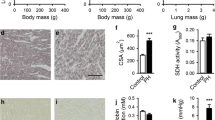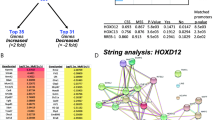Abstract
Chronic hypobaric hypoxia (CHH) increases load on the right ventricle (RV) resulting in RV hypertrophy. We hypothesized that CHH elicits distinct responses, i.e., the hypertrophied RV, unlike the left ventricle (LV), displaying enhanced mitochondrial respiratory and contractile function. Wistar rats were exposed to 4 weeks CHH (11% O2) versus normoxic controls. RV/body weight ratio increased (P < 0.001 vs. control) while RV systolic and developed pressures were higher. However, LV systolic and developed pressures were significantly reduced. Mitochondrial O2 consumption was sustained in the hypertrophied RV, ADP/O increased (P < 0.01 vs. control) and proton leak significantly decreased. Conversely, LV mitochondrial O2 consumption was attenuated (P < 0.05 vs. control) and proton leak significantly increased. In parallel, expression of mitochondrial regulators was upregulated in the hypertrophied RV but not the LV. Our data show that the hypertrophied RV induces expression of mitochondrial regulatory genes linking respiratory capacity and enhanced efficiency to sustained contractile function.

Similar content being viewed by others
References
Adrogue JV, Sharma S, Ngumbela K, Essop MF, Taegtmeyer H (2004) Acclimatization to chronic hypobaric hypoxia is associated with a differential transcriptional profile between the right and left ventricle. Mol Cell Biochem 278:71–78. doi:10.1007/s11010-005-6629-5
Sharma S, Taegtmeyer H, Adrogue J, Razeghi P, Sen S, Ngumbela K et al (2004) Dynamic changes of gene expression in hypoxia-induced right ventricular hypertrophy. Am J Physiol Heart Circ Physiol 286:H1185–H1192. doi:10.1152/ajpheart.00916.2003
Zungu M, Alcolea MP, Garcia-Palmer FJ, Young ME, Essop MF (2007) Genomic modulation of mitochondrial respiratory genes in the hypertrophied heart reflects adaptive changes in mitochondrial and contractile function. Am J Physiol Heart Circ Physiol 293:H2819–H2825. doi:10.1152/ajpheart.00806.2006
Rumsey WL, Abbott B, Bertelsen D, Mallamaci M, Hagan K, Nelson D et al (1999) Adaptation to hypoxia alters energy metabolism in rat heart. Am J Physiol 276:H71–H80
Nouette-Gaulain K, Malgat M, Rocher C, Savineau JP, Marthan R, Mazat JP et al (2005) Time course of differential mitochondrial energy metabolism adaptation to chronic hypoxia in right and left ventricles. Cardiovasc Res 66:132–140. doi:10.1016/j.cardiores.2004.12.023
Young ME (2003) Circadian rhythms in cardiac gene expression. Curr Hypertens Rep 5:445–453. doi:10.1007/s11906-003-0051-8
Sordahl LA, Besch HR, Allen JC, Crow C, Lindenmayer GE, Schwartz A (1971) Enzymatic aspects of the cardiac muscle cell: mitochondria, sarcoplasmic reticulum and noncovalent cation active transport system. Methods Achiev Exp Pathol 5:287–346
Essop MF, Razeghi P, McLeod C, Young ME, Taegtmeyer H, Sack MN (2004) Hypoxia-induced decrease of UCP3 gene expression in rat heart parallels metabolic gene switching but fails to affect mitochondrial respiratory coupling. Biochem Biophys Res Commun 314:561–564. doi:10.1016/j.bbrc.2003.12.121
Starnes JW, Barnes BD, Olsen ME (2007) Exercise training decreases rat heart mitochondria free radical generation but does not prevent Ca2+-induced dysfunction. J Appl Physiol 102:1793–1798. doi:10.1152/japplphysiol.00849.2006
Redout EM, Wagner MJ, Zuidwijk MJ, Boer C, Musters RJ, van Hardeveld C et al (2007) Right-ventricular failure is associated with increased mitochondrial complex II activity and production of reactive oxygen species. Cardiovasc Res 75:770–781. doi:10.1016/j.cardiores.2007.05.012
Babsky A, Doliba N, Doliba N, Saychenko A, Wehrli S, Osbakken M (2001) Na+ effects on mitochondrial respiration and oxidative phosphorylation in diabetic hearts. Exp Biol Med 226:543–551
Estabrook R (1967) Mitochondrial respiratory control and the polarographic measurement of ADP/Oratios. Methods Enzymol 10:41–47. doi:10.1016/0076-6879(67)10010-4
Lowry OH, Rosenbrough N, Farr AL, Radall RJ (1951) Protein measurement with the folin phenol reagent. J Biol Chem 193:265–275
Stavinoha MA, Rayspellicy JW, Hart-Sailors ML, Mersmann HJ, Bray MS, Young ME (2004) Diurnal variations in the responsiveness of cardiac and skeletal muscle to fatty acids. Am J Physiol Endocrinol Metab 287:E878–E887. doi:10.1152/ajpendo.00189.2004
Pissarek M, Bigard X, Mateo P, Guezennec CY, Hoerter JA (1997) Adaptation of cardiac myosin and creatine kinase to chronic hypoxia: role of anorexia and hypertension. Am J Physiol 272:H1690–H1695
Hochachka PW, Lutz PL (2001) Mechanism, origin, and evolution of anoxia tolerance in animals. Comp Biochem Physiol B Biochem Mol Biol 130:435–459. doi:10.1016/S1096-4959(01)00408-0
Essop MF (2007) Cardiac metabolic adaptations in response to chronic hypoxia. J Physiol 584:715–726. doi:10.1113/jphysiol.2007.143511
Goffart S, von Kleist-Retzow JC, Wiesner RJ (2004) Regulation of mitochondrial proliferation in the heart: power plant failure contributes to cardiac failure in hypertrophy. Cardiovasc Res 64:198–207. doi:10.1016/j.cardiores.2004.06.030
Huss JM, Imahashi K, Dufour CR, Weinheimer CJ, Courtois M, Kovacs A et al (2007) The nuclear receptor ERRalpha is required for the bioenergetic and functional adaptation to cardiac pressure overload. Cell Metab 6:25–37. doi:10.1016/j.cmet.2007.06.005
Essop MF, Opie LH (2004) Metabolic therapy for heart failure. Eur Heart J 25:1765–1768. doi:10.1016/j.ehj.2004.08.019
Jezek P (1999) Fatty acid interaction with mitochondrial uncoupling proteins. J Bioenerg Biomembr 31:457–466. doi:10.1023/A:1005496306893
Jezek P, Engstová H, Zácková M, Vercesi AE, Costa ADT, Arruda P et al (1998) Fatty acid cycling mechanism and mitochondrial uncoupling proteins. Biochim Biophys Acta 1365:319–327. doi:10.1016/S0005-2728(98)00084-X
Teshima Y, Akao M, Jones SP, Marban E (2003) Uncoupling protein-2 overexpression inhibits mitochondrial death pathway in cardiomyocytes. Circ Res 93:192–200. doi:10.1161/01.RES.0000085581.60197.4D
Horimoto M, Fulop P, Derdak Z, Wands JR, Baffy G (2004) Uncoupling protein-2 deficiency promotes oxidant stress and delays liver regeneration in mice. Hepatology 39:386–392. doi:10.1002/hep. 20047
Chatham JC, Seymour AM (2002) Cardiac carbohydrate metabolism in Zucker diabetic fatty rats. Cardiovasc Res 55:104–112. doi:10.1016/S0008-6363(02)00399-1
Milano G, Corno AF, Lippa S, von Segesser LK, Samaja M (2002) Chronic and intermittent hypoxia induce different degrees of myocardial tolerance to hypoxia-induced dysfunction. Exp Biol Med 227:389–397
Kurzelewski M, Duda M, Stanley WC, Boemke W, Beresewicz A (2004) Nitric oxide synthase inhibition and elevated endothelin increase oxygen consumption but do not affect glucose and palmitate oxidation in the isolated rat heart. J Physiol Pharmacol 55:27–38
Mozaffari MS, Patel C, Ballas C, Schaffer SW (2006) Effects of excess salt and fat intake on myocardial function and infarct size in rat. Life Sci 78:1808–1813. doi:10.1016/j.lfs.2005.08.014
Acknowledgments
The authors wish to thank Mr. Noel Markgraaff for technical assistance. This work was supported by an NIH-Fogarty R03 TW07344 (to M. F. Essop and W. C. Stanley), the South African Medical Research Council and the South African National Research Foundation (to M.F. Essop).
Author information
Authors and Affiliations
Corresponding author
Rights and permissions
About this article
Cite this article
Zungu, M., Young, M.E., Stanley, W.C. et al. Expression of mitochondrial regulatory genes parallels respiratory capacity and contractile function in a rat model of hypoxia-induced right ventricular hypertrophy. Mol Cell Biochem 318, 175–181 (2008). https://doi.org/10.1007/s11010-008-9867-5
Received:
Accepted:
Published:
Issue Date:
DOI: https://doi.org/10.1007/s11010-008-9867-5




